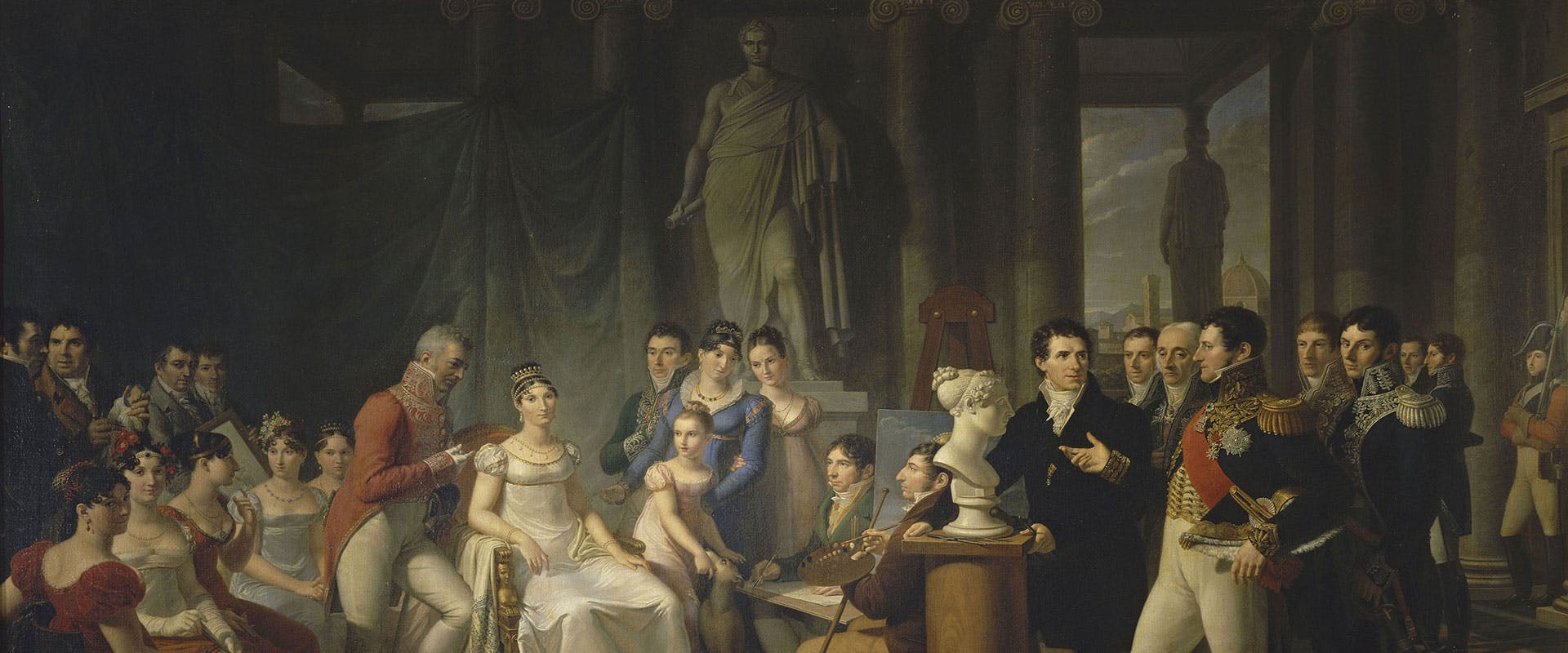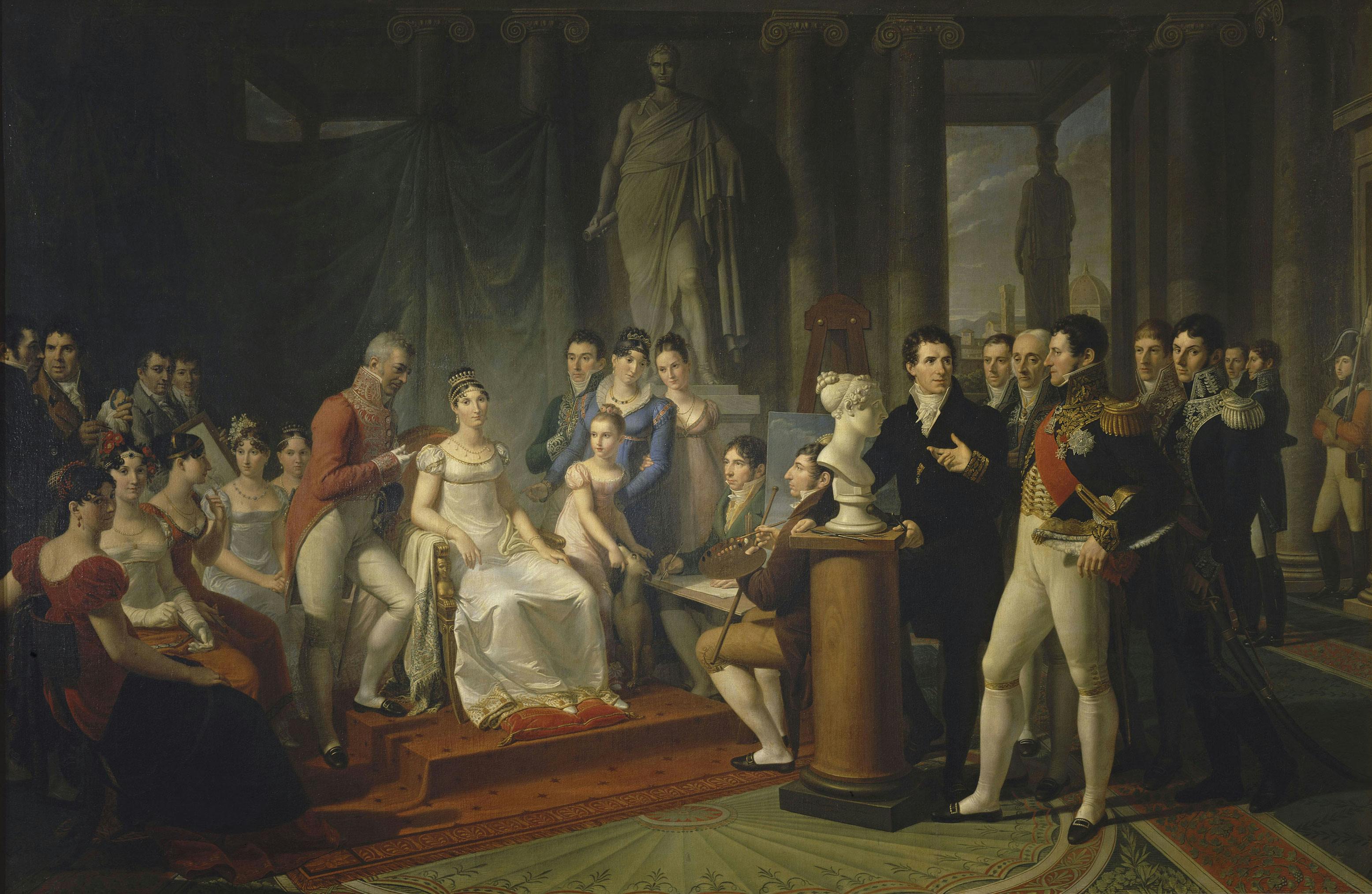Elisa Baciocchi and her court
Genesis of a painting
In the spring of 1812, Canova was staying in Florence, engaged in the unveiling and positioning of the Medici Venus. On that occasion, he also carved the bust of Elisa Baciocchi, Napoleon’s sister and Grand Duchess of Tuscany. Pietro Benvenuti, renowned Aretine artist, who at that time was Director of the Florentine Academy, as well as master of painting and principal court painter, was given the task of capturing the event on a large canvas that would celebrate the patronage of the Grand Duchess and at the same time the greatness of the sculptor. Although he took inspiration form the official imperial portraiture, as if the canvas depicted a solemn ceremony, Benvenuti modified the French tradition, putting on an equal footing the Grand Ducal family, the court dignitaries, the ladies-in-waiting (most of them belonging to the Florentine aristocracy), and the artists patronised by the sovereign. In the large painting, currently in Versailles, Elisa Baciocchi dominates the scene, sitting on the throne and posing like an inspirational muse to all the artists, who surround her in the attempt to make her appear as heiress of the great patrons of the arts in Florence. Twenty-seven life-size figures crowd the canvas. Standing in front of the sovereign, Canova is showing Felice Baciocchi the bust, placed on an elegant column-shaped pedestal. Next to the Grand Duchess is Baron Giovanni Degli Alessandri, who at that time was president of the Academy of Fine Arts and First Chamberlain to the sovereign, as well as a dear friend of Canova. He is showing Elisa the bust just unveiled. He was most likely the one who suggested Benvenuti for the iconography of the painting, to be interpreted as an homage to the sculptor, whom the Aretine painter was also very close to. Standing next to Elisa is her daughter, the little Napoléone, with a greyhound by her side. On the left, along with the ladies-in-waiting, is the artist Giovanni Antonio Santarelli, carving teacher and medallist, depicted while talking to Tommaso Puccini, chamberlain to the Grand Duchess and Director of the Uffizi Galleries, and showing a medallion he has just made. Towards the background of the painting, a little distant, is Raphael Morghen, who is holding under his arm the framed engraving taken from the painting Napoleon crossing the Alps. In the scene, Santarelli and Morghen ignore each other and seem like rivals.
The painting of the large canvas was carried out in different phases, which are documented by sketches preserved in the Department of Prints and Drawings of the Uffizi. These include overall designs as well as preparatory studies of the single figures. In the latest overall design, the real protagonist of the scene becomes Canova. When Benvenuti was drafting the painting, Canova had already left Florence to go back to Rome, so the painter was unable to portray him in person. For this reason, he used as a reference Canova’s portrait made by Francois Xavier Fabre, who is also depicted in the painting, and the one made by himself, stored at the Degli Alessandri household.
In the painting, the figure of the Prince Consort is relegated away from the throne. A major role is played instead by the most prominent painters of the Grand Duchy, Benvenuti and Fabre, who are standing at the centre, working at the easle to outline the sovereign’s face. Among the ladies-in-waiting are Countess Teresa Mozzi del Garbo, née Guadagni, whose pose had been studied separately in a sketch, and Princess Antonietta Corsini, née Waldstadten. The sovereign had more than thirty-three accompanying maids, four ladies-in-waiting, one reader and one maid of honour. On the opposite corner, behind the colonnade in Doric style and the Caryatids, which are an elaboration of those of the Erechtheum, a view of Florence opens up, giving the city the meaning of “New Athens of Italy”. The room is dominated by a monumental statue of Napoleon, who is portrayed wearing a toga and a laurel wreath. It bears some resemblance to the sculpture made in 1810 for the city of Livorno by Lorenzo Bartolini, great absentee in the painting.

